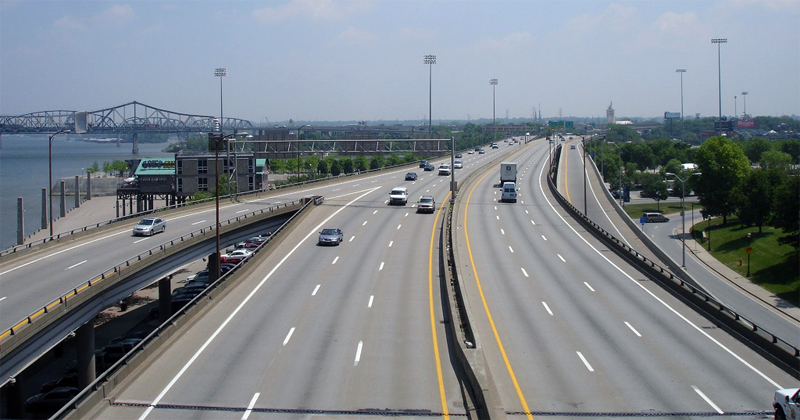
Interstate 64 running through downtown Louisville made it to 7th place on the Freeways Without Futures: Nation’s Least Wanted Highways list from the Congress For The New Urbanism. The list includes highways in some of the most progressive cities today: Seattle, New York, and Toronto to name a few.
While Louisville’s highway doesn’t rank first—that designation goes to a battle that’s been raging for years over the Alaskan Way Viaduct in Seattle—making it on to the list demonstrates national attention being drawn to our local planning issues. Here’s some information about the project from the CNU:
The “Freeways Without Futures” list recognizes the top-ten locations in North America where the opportunity is greatest to stimulate valuable revitalization by replacing aging urban highways with boulevards and other cost-saving urban alternatives. The list was generated from an open call for nominations and prioritized based on factors including the age of the structure, redevelopment potential, potential cost savings, ability to improve both overall mobility and local access, existence of pending infrastructure decisions, and local support.

CNU President John Norquist, former mayor of Milwaukee, Wisconsin, testified on behalf of 8664.org in front of Metro Council last January. Norquist was successful in removing a stretch of highway from his downtown, replacing it with a lively urban, pedestrian-oriented boulevard. He warned that streets are “not just about the traffic” and stressed the three equally important purposes of streets: movement, social, and economic. Streets, especially in a compact urban area, should adhere to these standards, something a new waterfront boulevard could accomplish. Norquist cautioned Louisvillians to guard against our city becoming just another truck stop along the highway, something he sees as possible with the new designs for Spaghetti Junction.
Louisville’s stretch of Interstate 64 running through downtown as described by the report:
Louisville’s riverfront, while lined with an award-winning park, is currently separated from downtown by an elevated, 6-lane portion of Interstate 64 (I-64), which connects with Interstate 65 and Interstate 71 just east of the downtown. In September 2003, the States of Kentucky and Indiana, working with the Federal Highway Administration, approved the Ohio River Bridges Project (ORBP), a project that adds two new bridges crossing the Ohio River and expands the junction of I-65, I-71, and I-64 in downtown Louisville. The project is estimated to cost $4.1 billion, with $1.6 billion going towards the expanded 23-lane interchange, commonly known as Spaghetti Junction.
Citizens, led by 8664.org, have been opposing the growth of Spaghetti Junction and calling for the rerouting of I-64 to a northern bypass around Louisville. This would result in a much simpler junction downtown and conversion of 2.0 miles of freeway from its existing limited-access configuration to an at-grade boulevard alongside a riverfront park. One benefit: 60 acres of prime reclaimed land. The traffic volumes in 2025 for this stretch are projected to be 100,000 average daily traffic (ADT). The local pro-boulevard organization 8664.org, with the help of feasibility report by the eminent Walter Kulash, predicts that with the rerouting, 20,000 vehicles per day would move to the bypass, 45,000 could be handled by the riverfront boulevard, and the rest could be easily accommodated by the existing street grid which currently has a 174,000-vehicle-per-day spare capacity on east-west streets in or near the riverfront corridor. As of August 2008, the Kentucky Transportation Cabinet temporarily suspended study of the 8664.org plan.
Here’s the full list of Freeways Without Futures:
- Alaskan Way Viaduct, Seattle, WA
- Sheridan Expressway, New York, NY
- The Skyway and Route 5, Buffalo, NY
- Route 34, New Haven, CT
- Claiborne Expressway, New Orleans, LA
- Interstate 81, Syracuse, NY
- Interstate 64, Louisville, KY
- Route 29, Trenton, NJ
- Gardiner Expressway, Toronto, ON
- 11th Street Bridges and the Southeast Freeway, Washington D.C.
- Freeways Without Futures (CNU)
- Highways to Boulevards Initiative (CNU)
- Why Freeway Removal Makes Sense (CNU)
- America’s Least Wanted Highways (StreetsBlog)



What a dream it would be to have 64 magically whisked away, replaced by waterfront shops and (floodproofed) outdoor cafes… to be rid of the ugly concrete canopies over Waterfront Park … to have Museum Plaza and have it looking straight down at the Ohio… to have the traffic downtown minor and humane and the whole sweep of the area open, pedestrian, artful and pleasing…
It will unfortunately be a long wait in this economy. There are visionaries in this town, but madness has the money…
I’m wondering why this “no-brainer” is not at it’s peak of conversation. Being the time for saving money, getting more jobs in the area and giving a surplus of riverfront property to the Louisville area. You would think that politicions would be jumping on this band wagon for all of the gains it would bring to the voters in this area.
I still can’t wonder why not a single person in government seemed to consider 8664 seriously. What a wonderfully progressive move it would have been that would have put Louisville on the map in many ways. The people with (or without) the money were just hell bent on building this $$billion$$ monster and serves to whisk people out of and through the city more efficiently that ever. Why would anyone ever bother to stop here? 8664 with an even more enhanced outer bridge would have done everything they wanted without the permanent scar imposed and years of memories of inconvenienced drivers. It’s not a bad bridge as bridges go..but not at for what we as a city paid for it.